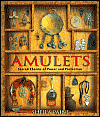
Showing a collection of amulets on the cover and containing full-color photos of genuine amulets on nearly every page, this book is survey of creativity and belief from around the world and throughout history. The author starts by defining terms. An amulet “is a device, the purpose of which is to protect, but by magical and not physical means—a lump of meteorite worn against gunfire is an amulet, a bullet-proof vest is not.” A charm is “something believed to bring good luck, health and happiness. It so doing, it might also be expected to protect from bad luck, sickness and misery, but protection is not its primary function.” A talisman is “something thought to be imbued with some magical property. It can both protect and radiate power, and is often used in ritual” (all three definitions on page 10).
Through all the ages and cultures of the world, people have created amulets out of cloth, buttons, beads, tassels, pieces of mineral, horns, teeth, claws, paws, bones, feathers, shells, tree bark, roots, leaves, flowers, … well, evidently, anything anyone can pick up and use can be turned into an amulet. Amulets have been used to protect our children, our homes, our businesses, our animals. They protect us from theft and lightning strikes, from sorcery and taxes and fearsome creatures. The illustrations show camels and taxi cabs and businessmen wearing amulets. There are amulets for brides and babies. There are hats and clothes covered with amulets and houses whose windows are painted blue for protection. There are dolls and goddesses, horseshoes and bells and bags of magic.
Even though amulets have long been considered to be pagan (in the pejorative sense), there is an old tradition of amulets using pictures and relics of saints, all properly blessed by the church. “[I]t is particularly in the Catholic church,” the author writes, “that saints—or depictions of them—bring the power of God to save infants from convulsions, men from demoniac temptations, women from a curse on childbirth, crops from hail and thieves, and people in general from apoplexy, strokes, and the evil eye” (p. 172).
This is not a how-to book. It doesn’t give step-by-step directions for creating amulets. It’s a book that explains what real people have actually used and made. There are photographs of hundreds of real amulets. However … we pagans are creative folks. We don’t have to go out and buy an Eye of Horus or an equal-armed cross or a cunning bag of herbs. We can make our own amulets, and we’re likely to find inspiration on every single page of this book. Instead of working with theory, we can learn what actual practice is and has been and build our own protective works of art for ourselves and our friends.
~review by Barbara Ardinger, Ph.D.
Author: Sheila Paine
Inner Traditions, 2004
